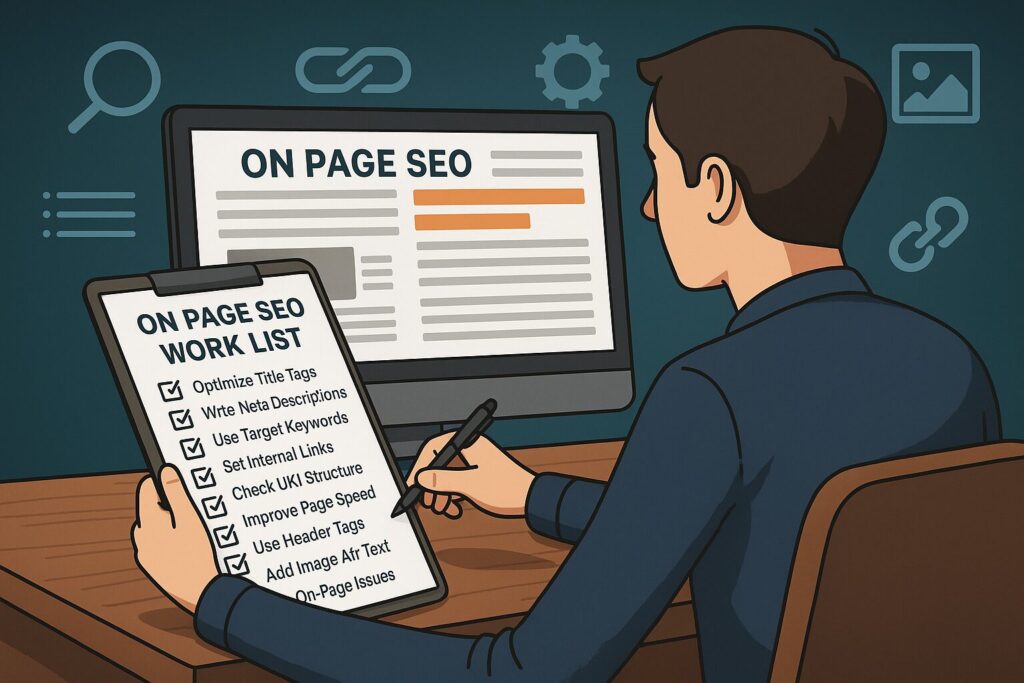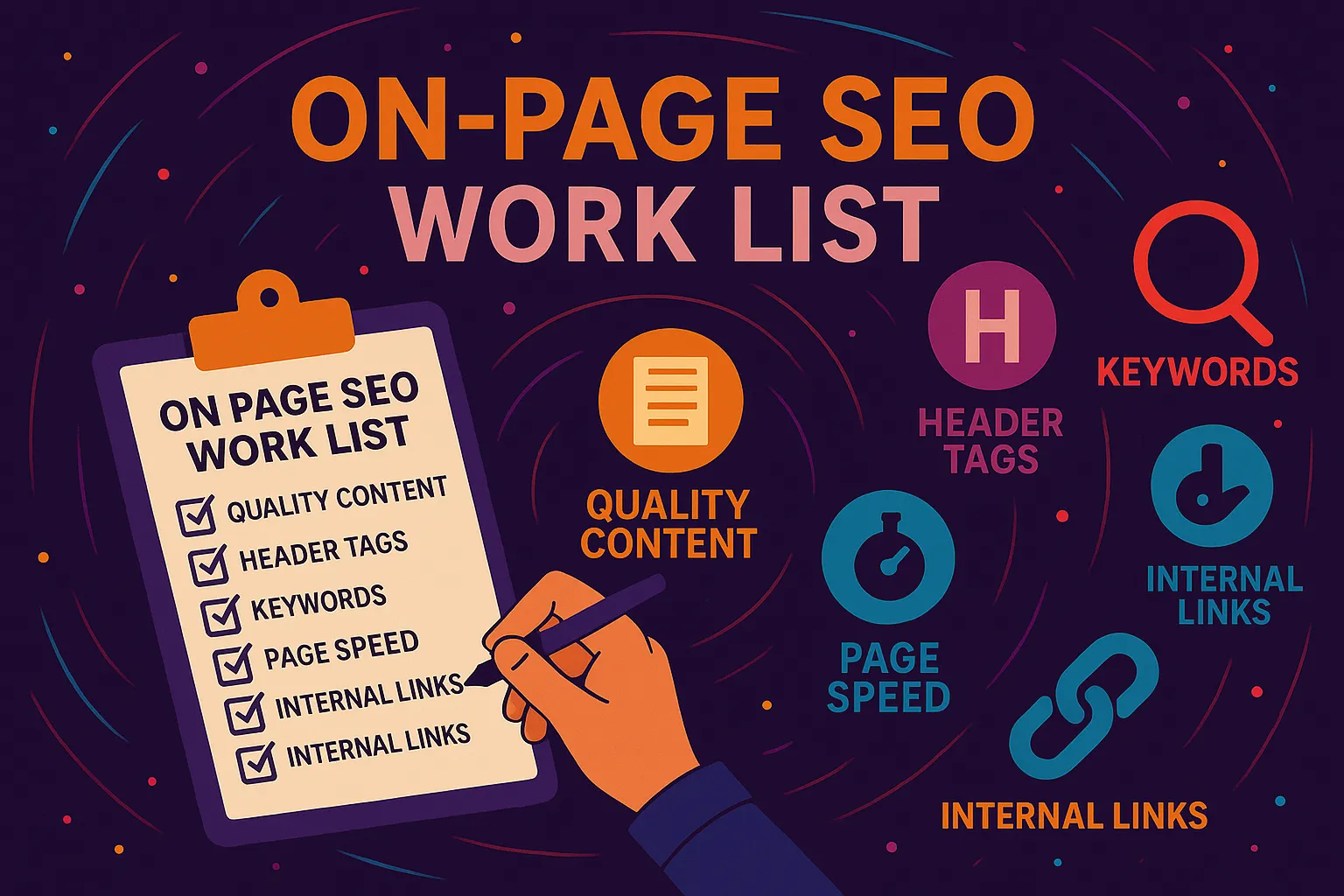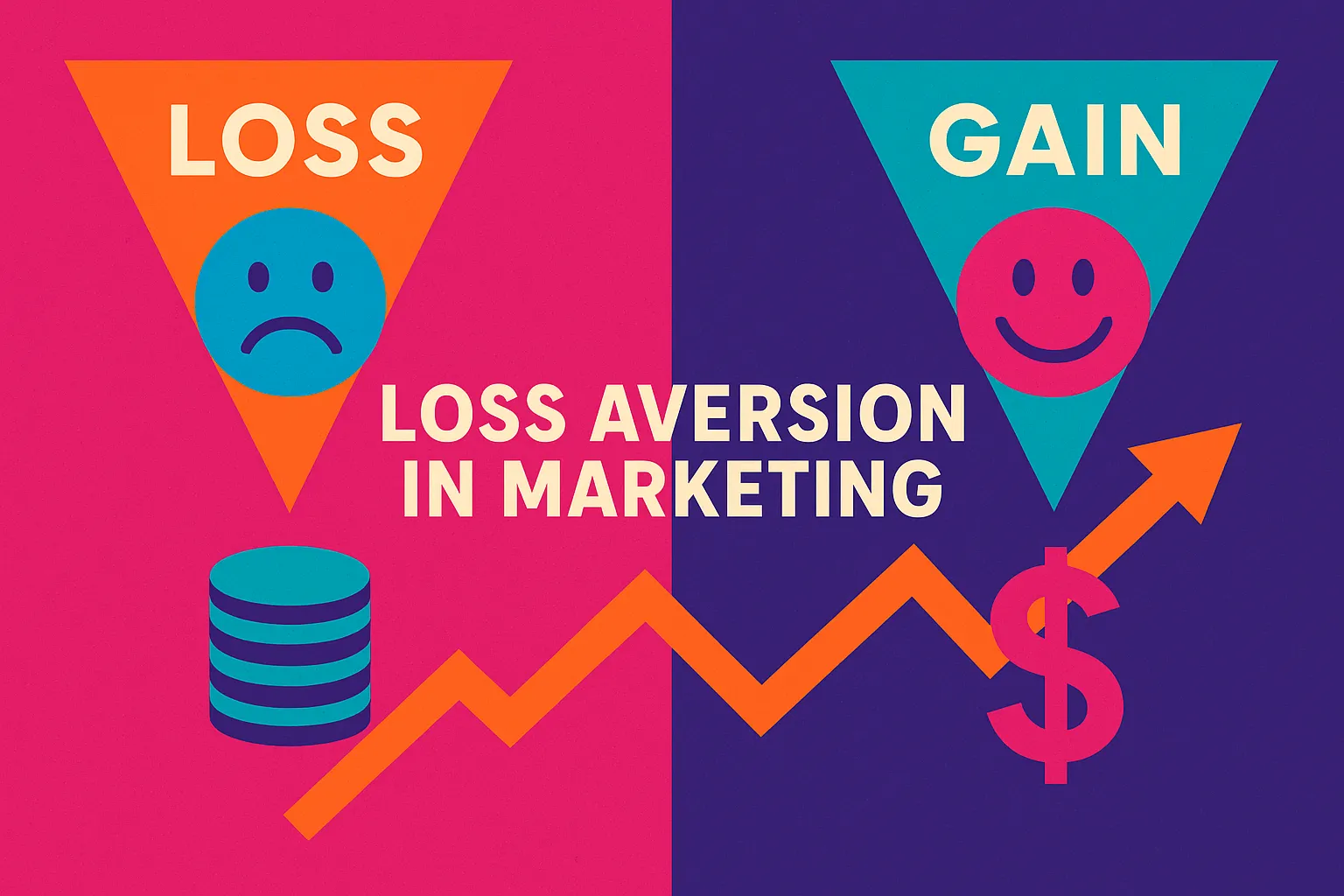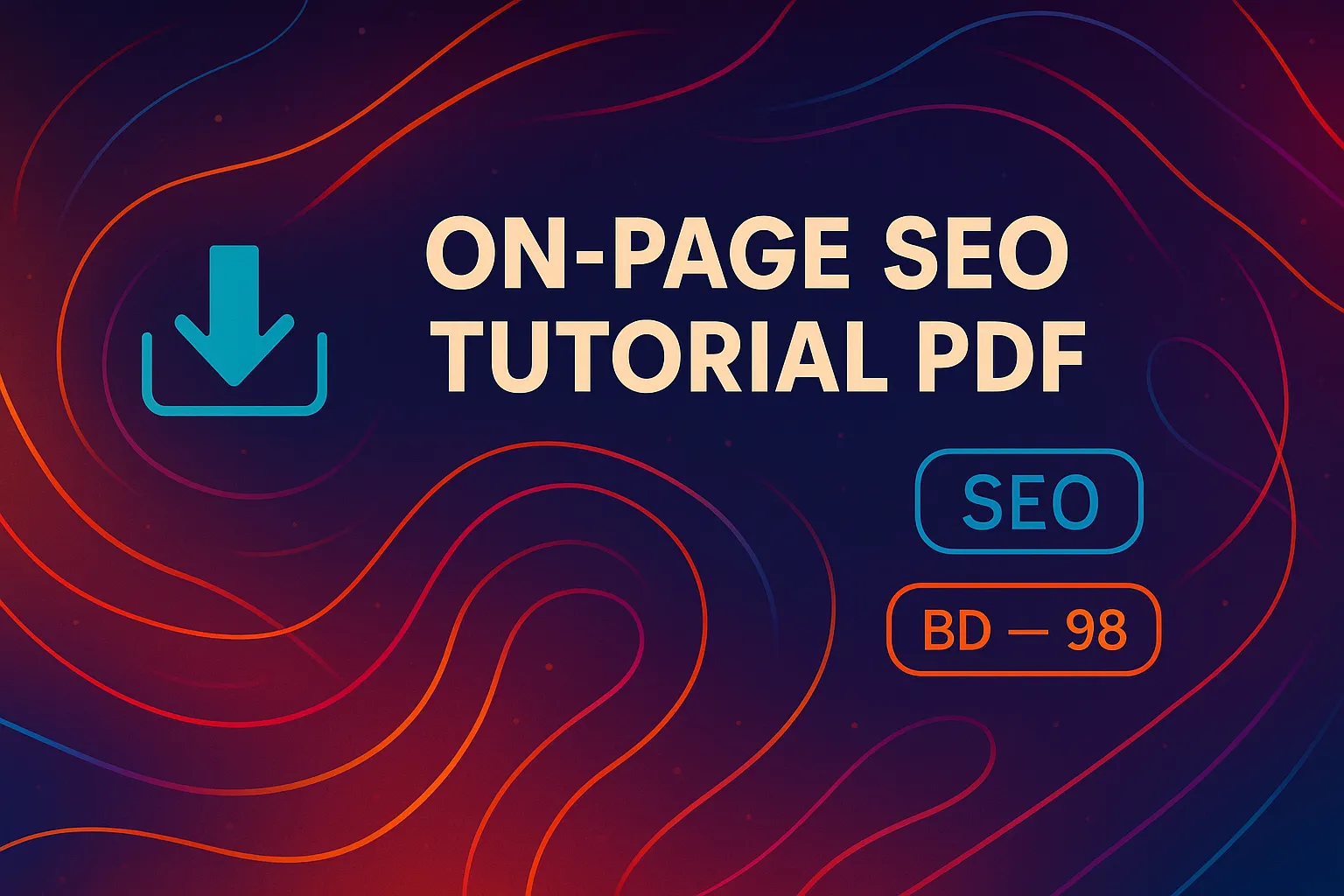What is an On Page SEO Work List?
An on page SEO work list is basically your action plan for optimizing a webpage so that it can rank better in Google. It’s a checklist—but one with power.
It covers everything you control directly on your webpage: title tags, keywords, headers, internal links, image tags, and more. I’ve learned that without this list, you’re flying blind.
And in digital marketing, especially now in 2025, flying blind is a recipe for invisibility. The list gives structure, and structure gives results.
After a decade of running SEO campaigns for everyone from startups to multimillion-dollar brands, I can confidently say: your rankings live and die by your ability to execute this list consistently.
TL;DR: Your Quick Guide to On Page SEO Work List
- Learn exactly what an on page SEO work list is and why it matters in 2025.
- Get step-by-step insights based on 10+ years of hands-on SEO experience at Vibe Branding.
- Understand how to use keyword research, metadata, links, and technical SEO to boost your visibility.
- Avoid the most common SEO mistakes while using our personal framework for success.
- Discover the best tools we use daily to automate our workflow and scale results.
How We Use Keyword Research to Start Our On Page SEO Work List
At Vibe Branding, we start with search intent. Always. If someone is Googling a question, they want a specific answer.
If they’re typing a product name, they might be ready to buy. Knowing what your audience wants before you start writing is the whole game.
We dive into tools like Semrush, AnswerThePublic, and Google Search Console to find that one primary keyword—the core of the content—and then build a cluster of supporting terms around it. We don’t write until that foundation is set.
That’s why when building your on page SEO work list, keyword research is step one, not step three. When I say this step alone has doubled traffic for some of our clients, I’m not exaggerating.
It’s the difference between writing for fun and writing for Google.

Why Title Tags and Meta Descriptions Can Make or Break Rankings
Once we’ve locked in our keywords, we turn to the first impressions: the title tag and meta description. They might seem small, but they’re often the deciding factor on whether someone clicks or scrolls past.
Your title tag should front-load the keyword and tell the user exactly what they’re going to learn or solve. The meta description should act like a preview, a teaser, a hook.
I’ve tested hundreds of variations, and the ones that perform best are direct, benefit-driven, and use strong verbs. For example, “Boost rankings with this 2025 on page SEO work list” outperforms “How to do SEO in 2025.”
It’s specific and active. This part of the work list needs its own space and attention—it sets the tone for everything else.
Headers Organize the Chaos (and Help You Rank)
We’ve seen time and again that Google loves well-structured content. That’s why H1, H2, and H3 tags aren’t just for looks—they’re for comprehension.
Your H1 should always include the exact match keyword, and each H2 should reflect subtopics that support the main idea. We usually plan our header tags before we even write the article.
Think of headers as chapters in your SEO story—they guide the user and the search engine from beginning to end. When reviewing client sites, I often find broken structure: multiple H1s, no keywords in H2s, or randomly placed H3s.
Fixing this is low-hanging fruit that brings fast ranking gains. And when it comes to our own site, this practice is baked into our editorial process.
Body Content: Where Depth and Keyword Usage Meet
If headers are the bones, body content is the muscle. This is where we flex our expertise and also show Google that we’re covering a topic thoroughly.
We make sure to include the keyword in the first 100 words, then pepper in related terms naturally throughout the content. But we never stuff.
Google’s smarter than that. At Vibe Branding, we write for people first and optimize second.
If the flow feels robotic, it won’t convert. So we add context, examples, and stories.
Like this: in one campaign, updating just the introduction to include a clearer keyword mention and adding two customer pain points boosted time-on-page by 27%. That’s the kind of insight only experience can teach.

Avoiding Costly Mistakes
One of the big pitfalls I warn about in the video is doing too much too fast. It’s easy to over-optimize and start keyword stuffing, which not only turns readers away but can hurt your ranking.
We teach you the balance between good optimization and spammy tactics. Another common mistake: using the same video or meta content on multiple pages.
That creates confusion for search engines and waters down your efforts. Our video shows you how to keep every page unique and focused, so you’re not competing with yourself.
We also dig into accessibility. Google rewards pages that are accessible to all users.
That means clear captions, well-structured content, and good contrast. It’s all part of SEO—and all covered in our video.
Clean URLs and SEO-Friendly Slugs Matter More Than You Think
One of the easiest things to overlook is your page URL. But it’s a real ranking signal—and a trust signal for users too.
We keep URLs short, clean, and keyword-rich. No crazy strings of numbers or unnecessary words.
For example, vibebranding.com/on-page-seo-work-list is perfect. It tells both Google and users what to expect.
Every time we audit a new client site, we find at least 3-5 slugs that could be improved. Fixing those helps clean up sitemap logic and strengthens relevance across internal links.
We also make sure to redirect old URLs to preserve authority, which is something many people skip.

Why Image Optimization is Part of Every On Page SEO Work List We Use
We use a lot of visual content—custom graphics, data charts, annotated screenshots. But we never just drag and drop. Every image gets a descriptive filename (like “on-page-seo-header-tags.png”) and clear, keyword-friendly alt text.
We also compress images to keep load times fast. Tools like TinyPNG or ShortPixel are lifesavers.
Optimizing images isn’t just about SEO—it improves user experience and accessibility. Google now indexes images for visual search, so skipping this step is like leaving rankings on the table.
On a recent site rebuild, adding image optimization alone increased organic image impressions by 48% in less than 30 days.
Technical SEO That Supports On Page SEO
You can have the best content in the world, but if your page loads slowly or isn’t mobile-friendly, Google won’t care. That’s why every on page SEO work list we build includes technical basics.
We always run a Core Web Vitals audit before and after publishing new content. Page speed, layout shift, and interactivity matter now more than ever.
We also check crawlability using Screaming Frog or Semrush and make sure our robots.txt and XML sitemap are in order. This part isn’t flashy, but it’s essential.
And from our experience, technical SEO is usually what separates a page that ranks #5 from one that hits the #1 spot.
Content Auditing and Refreshing: When to Revisit Your SEO Work List
Content isn’t one-and-done. At Vibe Branding, we run quarterly content audits.
We review analytics, compare against current search intent, and refresh pages with new data or updated links. If a keyword’s intent has shifted, the page needs to shift too.
We’ve built a Google Sheets doc that tracks all of this—a living SEO work list. When we refreshed our “Google Business Profile Optimization” post last year with updated screenshots and current tips, it jumped from position 12 to position 3 in under two weeks.
Keeping content fresh shows Google (and your audience) that you care about accuracy and value.

Common Mistakes We See (and Fix) All the Time
If there’s one section I wish every business owner would read, it’s this one. The biggest mistake?
Thinking SEO is a one-time task. It’s not.
Other issues we constantly fix include keyword stuffing, having multiple H1s, slow mobile load times, and using generic meta descriptions. Another sneaky problem: duplicate content caused by tag pages or poor CMS settings.
We also see people forgetting to set up redirects when they change URLs, which tanks their rankings overnight. The fix is usually simple, but it takes experience to spot.
That’s why our team builds every on page SEO work list with a double-check mindset—we don’t assume anything’s perfect on the first pass.
Our Favorite Tools for Building and Automating the On Page SEO Work List
Let’s talk tools—because you can’t scale quality SEO without them. We use Semrush’s On Page SEO Checker for quick content and tag audits.
For writing, Surfer SEO helps us understand keyword density and NLP terms. Screaming Frog crawls technical issues fast, and Google Search Console is non-negotiable for live feedback.
We also use AnswerThePublic and AlsoAsked for content ideation. These tools help us spend less time guessing and more time optimizing.
If you’re building your first SEO work list, start with a free trial of one or two, then build from there. Tools don’t replace strategy—but they sure speed up success.
Why This On Page SEO Work List Works
After 10 years of helping businesses grow through search, we’ve learned that there’s no shortcut—just the right sequence. This on page SEO work list isn’t just a theory.
It’s the exact framework we’ve used for our clients and for our own growth at Vibe Branding. Every line of metadata, every alt tag, every slug—it all adds up. And while trends in SEO evolve, the fundamentals haven’t changed.
They’ve only become more critical. Google rewards clarity, speed, structure, and relevance.
This list helps you deliver on all fronts. If you follow this guide with consistency, not only will you rank—you’ll stay ranked.
That’s the difference between traffic spikes and sustained growth. And that’s why we’re proud to call this our go-to process.





